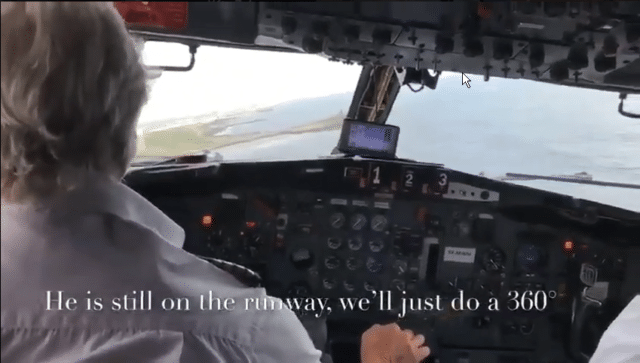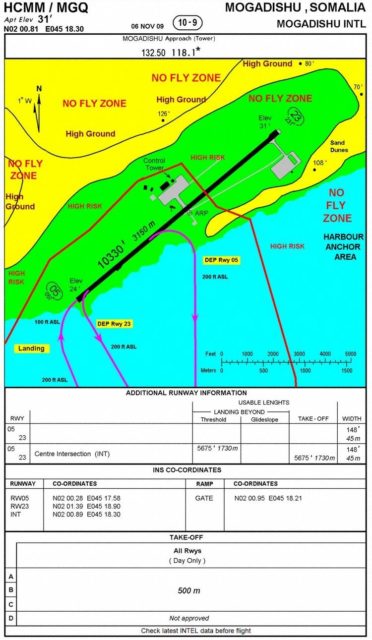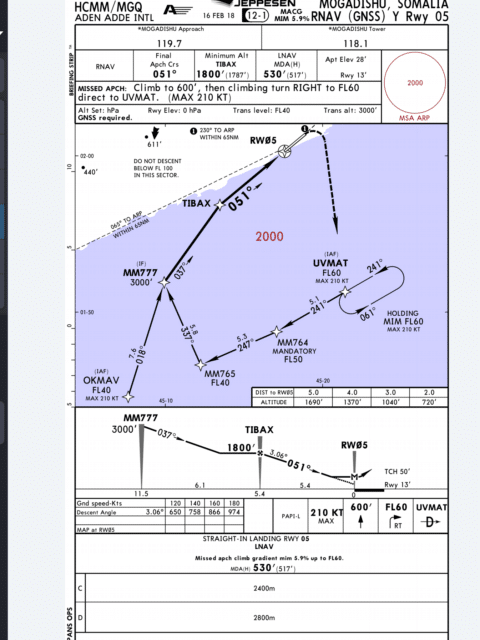360° at 100 feet

Last week, “Captn Al” called out poor decision making in a video of an 727 doing a low-level 360° when he found the runway occupied by a light aircraft.
In a week where there have been videos of poor decision making below MSA, sadly here’s another one. Accidents just don’t happen, they are caused! #flying #safety #planesafetypodcast pic.twitter.com/yG9Yh8XjWT
— Captn Al (@airbus_al) December 2, 2019
Of course, I had to find out more.
Here’s the fullsized video:
I also found a second video of the same flight taken from the beach:
The aircraft is a Boeing 727 registration FY-MWM (previously N446BN) which has a long and interesting history. Here’s the final paragraph:
In 2014, Ship N446BN was stored at an unknown location in Africa. In addition, the aircraft was listed on several jet freighter available lists as being available for service. The aircraft was eventually sold to Astral Aviation sometime after 2014. However, as of February 2019, the aircraft is currently operating for Astral Aviation of Nairobi, Kenya. Ship N446BN was reregistered in Kenya as 5Y-MWM.
So that’s our plane.
The airport in the video is Aden Adde International Airport in Mogadishu, the capital of Somalia.
Here’s an old plate from the airport which was posted to the Professional Pilots’ Rumour Network. Note the no-fly zone:

Here’s the modern approach which still clearly keeps all traffic away from the land.
Somalia has been ravaged by armed conflict for almost three decades and violent attacks are a part of daily life in Mogadishu. Flying circles at 100 feet above the water in a 50-year-old plane sounds pretty frightening but one poster makes the comment that the 727 is less of a target doing a 360° off-shore than following the missed approach over a surface-to-air missile detail.
Air Force Veteran Scott Bateman adds some context to the decision to circle at low level:
I first came to Mogadishu just before Xmas ‘92. It was dark and we landed at the airport the evening before the US Navy Seals were caught by CNN coming up the beach just to the north. It’s was then, and still is, a challenging place to aviate into.
Weapons are plentiful and when combined with the use of narcotics they are often fired randomly at anything, including aircraft. So it’s worth avoiding flying over any built up areas, period.
You will now understand why all #aircraft flying into here would want to remain over the water at all costs. A standard go around has the potential to be problematic. They always land & depart over the water, this avoiding risks from small arms fire.
The last time I landed at Mogadishu, I was wearing body armour and also sitting on a flak jacket to protect my “jewels”. Whilst the 727 manoeuvre is unconventional and probably risky, I wouldn’t judge as I have no idea of the current threat from ground fire or similar.
The pilot of the aircraft was apparently recognised on the Professional Pilot’s Rumour Network with one poster posting that Niel was jailed for over a year in Zimbabwe as the pilot of the Boeing 727 seized by Zimbabwean authorities in 2004. It sounds like this isn’t the man’s first time in a conflict zone.
Based on that, I found this YouTube channel by Niel Steyl including a video of him flying a 727-200 into, you guessed it Mogadishu, Somalia with Van Halen playing loudly in the background. It seems pretty likely that this is the same man.
Niel Steyl is a South African pilot who was indeed held for 17 months in a maximum security prison in Zimbabwe after being accused of having stopped to pick up weapons to overthrow the government of Equatorial Guinea.
Watching the video, I have to admit I’m impressed to watch the flight crew was acting as a team, the captain briefing before he starts the turn and the first officer looking out and watching. At the start and then again as they come back around, you can hear the callout of 100 feet — Steyl completed that 360° without losing an inch. I don’t think I’d want to be in that aircraft but I have to concede that he’s one hell of a pilot.









My computer does not respond when I want to see the video.
A pity because a 360 in a B727 at 100 feet? That is just about the aircraft’s wingspan. Over water, OK it is totally flat, but the tiniest mistake can cause a wingtip to create a wake in the water. Which would mean: a cartwheel and inevitable disaster. A very dangerous stunt, only justifiable because the alternative would carry even greater risks.
It would require supreme flying skills to pull this one off, though.
You can find the first clip at https://youtu.be/rcRhoY5azgM .
The second clip just shows the light aircraft coming in and then the 727 approaching and circling, from a viewpoint outside the airport fence in line with the runway.
I took some screenshots and measured the angle of the horizon vs. the top of the windshield, and I believe the bank angle reaches a maximum of 45°.
What with the power variations and the bank angle shifting, they still complete the circle not too badly off the runway alignment, which is another achievement right there: going from descent to level flight at this steep an angle and then easing up on the throttle again to go back onto the glide path (why is it call glide path when you fly it powered?) and ending up at pretty much the same place both laterally and vertically seems not an easy task at all!
They simply should have gone around… one of the things that makes a pilot a good pilot is to have superior skills that you try not to use…anyway it is mostly wrong decisions that leads to crashes
Jan Lievaart, I don’t understand how your comment addresses Sylvia’s article, or my comment. The point of the article was to explain that, under the circumstances, this was indeed a good decision to make, as it solved the situation that presented itself within the abilities of the airplane and the pilot.
Thanks Mendel, I got it this time! I will try and get the second clip too. The subject shifted to another aviation incident after this had been played.
Glide path? Well, I guess that it got its name from the early days when the ILS was first introduced. Modern jets fly the approach in a high drag / high power setting configuration. It takes a while for a large jet engine to spool up from flight idle to deliver the power needed to go around, critical when the aircraft is nearly at DH. The old propeller engines could accelerate much more quickly, and besides the props would deliver an instant airstream over the wings to give a bit of extra lift. A jet needs to accelerate first, not just the engines but the whole aircraft, for the lift to build. So the speed control is much more critical and power in a stabilised approach may be in the order of around 65% in order to ensure quick acceleration when needed in a missed approach. So a jet flies the approach in a much more critical configuration and a tightly controlled angle of attack, speed and power setting.
Which makes the 360 which is the subject of Sylvia’s entry this week even more impressive. From my perspective as a former professional pilot even spectacular, and the more impressive given the very quick risk assessment that led the crew to opt for this 360 in favour of a more sedate standard go-around.
Looks like that particular pilot might have logged quite a few hours flying jets under the radar?
This https://youtu.be/PskS77toQOY is the bottom video in the article, Niel Steyl flying an approach into Mogadishu that involves coming in almost perpendicular to the coast and turning right at the last moment for the short final. Looking at the plates that Sylvia provided, this looks a lot like the older approach, and that does involve a ~75° turn at 100′ ASL — well, that one had no final at all, actually, as the charted turn arc ends over the runway threshold. If you do not know exactly how much height your airplane is going to lose on a turn like that in a short final situation, that’s not going to end well!
Jan Lievaart does make a valid point, except: we do not know what the risk factor would have been if they actually HAD made a go-around.
So we probably must accept that under the circumstances this crew did make a decision that otherwise should have been pigeon-holed under the category: Very dangerous, irresponsible show-off.
But since we do not know what risk factor the alternative had, and given that they did pull off this stunt without any crash, I think that they should at least be given the benefit of the doubt.
Rudy — your reaction to the bank angle was pretty much what I was thinking, although the 2nd video makes it look like the plane had a fair margin above the water. I was also surprised that such a steep bank produced only a slightly-tighter-than-standard turn (100 seconds vs 120) despite being relatively slow, but I don’t remember the formula for how bank angle for a given rate of turn changes with airspeed.
I suppose the instructions for a missed instrument approach assume that the loonies with weapons won’t be able to see their target, so the plane can stay on a straight course and get a little more altitude before turning, rather than making the sharp departure turn. However, ISTM that a more-cautious pilot in this case would have climbed straight ahead until nearing the standard departure-turn point, keeping clear of hazard while getting much more air under the plane; this looks like a pilot taking an excessive risk, maybe in order to get on the ground faster, or maybe to show off to whoever (a student?) was at the back of the cockpit making the video. (I wonder whether that person was warned that a hotshot was in the left seat and had their phone running in case there was an enquiry.)
Mendel: my recollection of an ancient set of printed instructions is that the VFR approach to JFK runway 13R had a noise-abatement turn that continued almost to the runway — but that runway is over 14,000 feet long, so a high approach could still land safely (and would be nearer the terminals…). I also recall that there were indicators along the arc.
Given the circumstances, I can only applaud the flying skills required. I could possibly pull this off in a light aircraft, but a 727 will wander 1000 feet off altitude in a matter of seconds, so keeping a steady altitude through a 360 with such tight margins is no small feat.
As a side note, I once experienced being beneath the flight path of a 727 executing a missed approach back at Denver Stapleton. I stepped outside the building just as a 727 barreled past, probably about 100’ up and scratching for altitude. It was an unforgettable experience.
Wow, amazing videos! Very skilled pilots!!
Regardless of why the captain decided to do a 100ft 360, that’s some of the best & most precise flying I’ve ever seen especially in a 70 ton jet! Also, I wouldn’t be too quick to judge as I would certainly balk at the choice between that or a possible AA missile up my Kyber Pass on a textbook GA! Personally, think he’s got balls of steel faced with those choices. Extraordinary.
Why would captain Steyl fly the 360 at such a steep bank angle? It seems like an ordinary 30 degree bank would have been safer to fly while still keeping him away from ground fire.
That was AC/DC playing Thunderstruck was the song
I’m not an expert, merely a fan of aircraft and Sylvia’s postings. I agree with Mendel that the bank angle is, or is close to, 45 degrees. I read here that the pilot did the 360 without losing an inch in altitude. As people say, he is a hell of a great pilot. It must have been quite something to be a passenger on that flight though – 45 degree bank!
I do have my pilot’s licence though.
Another 360 by Neil in a 737. This time at Juba, South Sudan in 2013: https://www.youtube.com/watch?v=ZpntvQvOGHI
Having been a passenger on a number of commercial flights Vickers Viscount) in 1978 Rhodsia (where I was born and brought up) during the Bush War, I know that pilots had non-standard approach and departure procedures to avoid attack from the ground. A departure could be low while rapidly gaining speed followed by a steep climb to get above STRELA range . Two viscounts were shot down departing Kariba in September 1979 (27 days beofre my wedding in then Gwelo, now Gweru) and February 1979 – after I had left Rhodesia with my wife – see https://en.wikipedia.org/wiki/9K32_Strela-2
A few more details.
I first left Rhodesia in 1970, but returned in mid 1978 to bury my father and again in September to get married.
Here is some more on the first Viscount crash. It occurred when the inner starboard engine was hit by the missile. There were originally 18 survivors, but 10 were gunned down by militants. There was also a sermon preached by the Dean of Salisbury which was recorded and made available. I have included a link. It actually has some relevance to the current situation.
THE HUNYANI DISASTER
“A compilation of newspaper reports
On the evening of 3 September 1978 Rhodesians were shocked by the news that terrorists of Joshua Nkomo’s ZIPRA had shot down a Rhodesian Viscount airliner, the “Hunyani”, using a Soviet-made Sam-7 missile. The airliner, carrying 52 passengers and 4 crew members vanished from radar screens five minutes after its 5.05 p.m. takeoff from Kariba airport. Almost immediately a distress signal was received to the effect that the engines had failed. The aircraft crashed near the northern border with Zambia in the Urungwe Tribal Trust Land, 40 km south-east of Kariba Dam. Eighteen people survived the crash.
The crash itself was shocking news, but the fate that awaited some of the survivors was to cause a wave of revulsion throughout Rhodesia. The following are newspaper reports of the event and aftermath.”
http://www.rhodesia.nl/viscount.htm
The Silence is Deafening
Sermon by Very Rev. John da Costa, Anglican Dean of Salisbury
Transcript:
https://www.christianaction.org.za/index.php/articles/god-and-government/164-the-deafening-silence-transcript-of-taped-broadcast
Just noticed my mistake – Boeing 737 should read Boeing 727-200!
By chance, I saw a trailer for an older aviation-related movie, and was somehow reminded of this post…